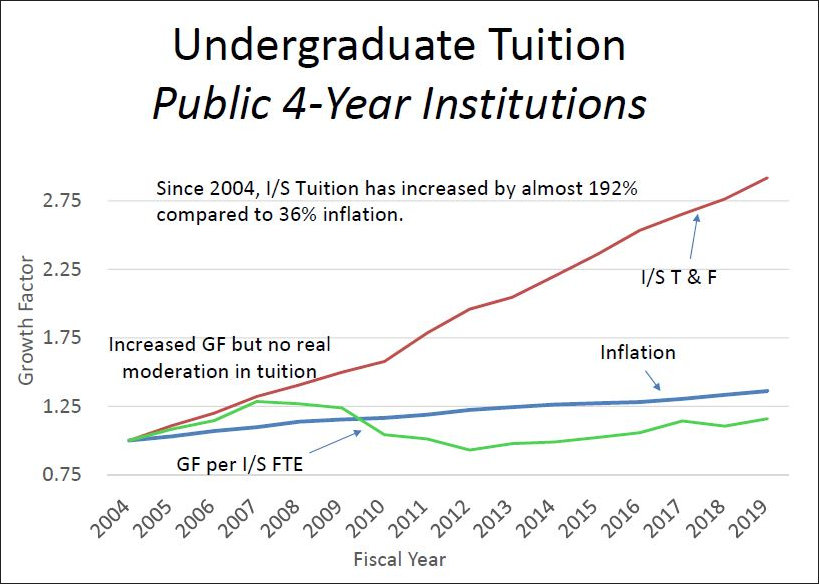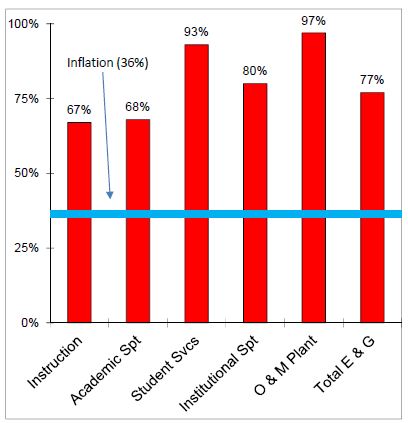by James A. Bacon
I don’t know what’s going to happen to Tony Maggio, a fiscal analyst with the House Appropriations Committee since 2001, when Democrats take control of the General Assembly. I wouldn’t be surprised if the new leadership finds his analysis, such as the graph above, to be highly inconvenient.
That graph shows the history of tuition & fees at Virginia’s public four-year institutions for undergraduate, in-state (I/S) students. It is inconvenient because it clearly shows how cuts to state support for higher education account for only a small portion of the increasing unaffordability of higher education. As such, the analysis undermines the argument — that cuts to state support are mainly to blame for higher college costs — advanced by a favorite Democratic Party constituency.
The graph appears in a PowerPoint presentation, “Update on Higher Education Affordability,” that Maggio made during the House Appropriations Committee retreat earlier this week. That PowerPoint also shows how higher-ed spending, not cuts in state support, is driving the cost increases.
Instructional spending per student grew by about 67% over the 15 years covered, about double the rate of inflation. Spending on academic support increased 68%, on institutional support by 80%, on student services by 93%, and on buildings, facilities and maintenance by an astounding 97%. Overall E&G (educational and general) spending increased 77%.
Another perspective: Compared to the 50 states, Virginia ranked 31st in 2004 in total spending per full-time-equivalent student. By 2018, spending per FTE student had increased to 21st highest in the country.
To counteract rising tuition, the state has significantly increased financial aid — about 211% over the 15-year period analyzed compared to 36% inflation. Needless to say, financial aid goes overwhelmingly to less affluent students. Maggio doesn’t say this, but the implication is clear: Students from middle-class students are getting the shaft. They pay more in tuition, fees, room, and board but get little of the financial aid.
Virginia colleges have done some things to improve efficiency in certain areas, Maggio says:
- Energy management
- Business services
- Purchasing consortia
But they may need to look at academic areas more closely, he suggests.
- Course loads / class size
- Adjunct faculty
- Expanded use of online
- Course offerings / program review
- Departmental mergers
In addition to highlighting some existing priorities — reducing time to complete degrees, expanding alternative pathways, increasing use of community colleges — Maggio raises the issue of “right-sizing” institutions, not something we’re likely to hear from the institutions themselves.
Bacon’s bottom line: Pair this post with the previous one about runaway medical insurance costs. Virginia public policy affecting two of the biggest expenses in the middle-class family budget — health care and college — transfers massive wealth from the middle class to the special interests (hospitals, insurers, doctors, college administrators, professors) and the poor.
It’s to be expected that Democrats will do their best to obscure this reality. What’s shocking is how Republicans have failed to exploit it. While fixating on taxes (a legitimate issue but only a small part of the middle class’s plight) and such ephemera as gun control laws (which would marginally curtail the rights of gun owners), the GOP looks on ineffectually while the middle class is plundered.
I have no idea what fate awaits Maggio — I’ll be honest, I have no idea how these things work — but it won’t surprise me if his new House Appropriations Committee overlords replace him with an analyst more sympathetic to the Democrats’ way of thinking. That would be a true loss, for Virginians would be even more in the dark about what’s happening in public higher education than they are today.




